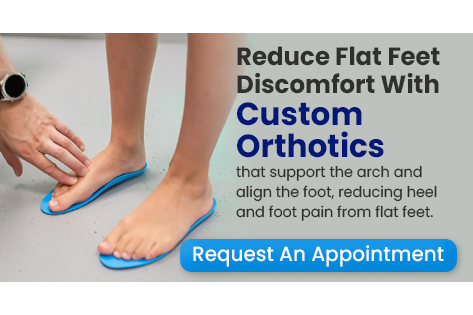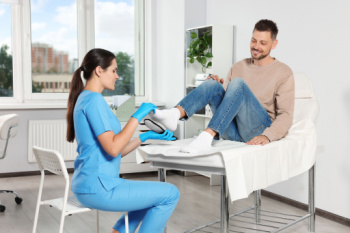
Chronic tendon injuries in the foot and ankle happen when a tendon becomes irritated or damaged over time, often due to overuse, poor foot mechanics, or past injuries that did not fully heal. Examples include Achilles tendinopathy and posterior tibial tendon dysfunction. These conditions can cause long-lasting pain, stiffness and weakness, especially during activity. Treatment focuses on reducing stress on the tendon and supporting healing. This may involve rest, custom orthotics, stretching and strengthening exercises, targeted exercises, or anti-inflammatory treatments. In more severe cases, advanced therapies or surgery may be considered. Chronic tendon injuries do not usually improve on their own and can worsen if left untreated. If you have ongoing foot or ankle pain that seems to flare up during movement or does not go away with rest, it is suggested that you see a podiatrist for proper evaluation and care.
Achilles tendon injuries need immediate attention to avoid future complications. If you have any concerns, contact one of our podiatrists of Premier Ankle & Foot Specialists. Our doctors can provide the care you need to keep you pain-free and on your feet.
What Is the Achilles Tendon?
The Achilles tendon is a tendon that connects the lower leg muscles and calf to the heel of the foot. It is the strongest tendon in the human body and is essential for making movement possible. Because this tendon is such an integral part of the body, any injuries to it can create immense difficulties and should immediately be presented to a doctor.
What Are the Symptoms of an Achilles Tendon Injury?
There are various types of injuries that can affect the Achilles tendon. The two most common injuries are Achilles tendinitis and ruptures of the tendon.
Achilles Tendinitis Symptoms
- Inflammation
- Dull to severe pain
- Increased blood flow to the tendon
- Thickening of the tendon
Rupture Symptoms
- Extreme pain and swelling in the foot
- Total immobility
Treatment and Prevention
Achilles tendon injuries are diagnosed by a thorough physical evaluation, which can include an MRI. Treatment involves rest, physical therapy, and in some cases, surgery. However, various preventative measures can be taken to avoid these injuries, such as:
- Thorough stretching of the tendon before and after exercise
- Strengthening exercises like calf raises, squats, leg curls, leg extensions, leg raises, lunges, and leg presses
If you have any questions please feel free to contact our offices located in South York, West York, and East York, PA . We offer the newest diagnostic tools and technology to treat your foot and ankle needs.

Flat feet? Rise above the discomfort with Custom Orthotics. Specifically designed to support the arch and align the foot, Custom Orthotics can be a game-changer for those with flat feet. They help in distributing weight evenly, preventing undue stress and potential pain. Walk, run, or stand with newfound confidence, knowing your feet have the support they've been missing. Want to explore the benefits of Custom Orthotics tailored for flat feet? Contact us today!

Sinus tarsi syndrome is a painful condition that affects the outer part of the foot, specifically in the small cavity between the talus and calcaneus bones. Often resulting from an ankle sprain or repetitive strain, sinus tarsi syndrome leads to inflammation and instability in the area. People with flat feet or who engage in activities like running, dancing, or sports that involve quick turns or uneven surfaces, are more likely to develop sinus tarsi syndrome. Symptoms include persistent, dull pain on the outer foot, along with tenderness and a feeling of instability, which often worsens with activity or walking on uneven ground. Diagnosing this condition typically involves a physical examination and imaging tests like MRI scans. Treatment may include rest, anti-inflammatory medication, and custom orthotics for support. In more severe cases, steroid injections or even surgery may be needed for long-term relief. If you have pain on the outer part of your foot, it is suggested that you schedule an appointment with a podiatrist for a proper diagnosis and appropriate treatment.
Ankle pain can have many different causes and the pain may potentially be serious. If you have ankle pain, consult with one of our podiatrists from Premier Ankle & Foot Specialists. Our doctors will assess your condition and provide you with quality foot and ankle treatment.
Ankle pain is any condition that causes pain in the ankle. Due to the fact that the ankle consists of tendons, muscles, bones, and ligaments, ankle pain can come from a number of different conditions.
Causes
The most common causes of ankle pain include:
- Types of arthritis (rheumatoid, osteoarthritis, and gout)
- Ankle sprains
- Broken ankles
- Achilles tendinitis
- Achilles tendon rupture
- Stress fractures
- Tarsal tunnel syndrome
- Plantar fasciitis
Symptoms
Symptoms of ankle injury vary based upon the condition. Pain may include general pain and discomfort, swelling, aching, redness, bruising, burning or stabbing sensations, and/or loss of sensation.
Diagnosis
Due to the wide variety of potential causes of ankle pain, podiatrists will utilize a number of different methods to properly diagnose ankle pain. This can include asking for personal and family medical histories and of any recent injuries. Further diagnosis may include sensation tests, a physical examination, and potentially x-rays or other imaging tests.
Treatment
Just as the range of causes varies widely, so do treatments. Some more common treatments are rest, ice packs, keeping pressure off the foot, orthotics and braces, medication for inflammation and pain, and surgery.
If you have any questions, please feel free to contact our offices located in South York, West York, and East York, PA . We offer the newest diagnostic and treatment technologies for all your foot care needs.

Plantar fasciitis is the leading cause of sharp heel pain, especially during the first steps in the morning or after periods of rest. Foot orthoses help alleviate this discomfort by providing arch support, cushioning, and improved foot alignment. By redistributing pressure across the foot, orthotic devices reduce strain on the plantar fascia, allowing it to heal and function more efficiently. Proper support also prevents excessive flattening of the arch, which can contribute to ongoing inflammation and pain. Orthotics with shock-absorbing materials help soften the impact of each step, making movement more comfortable. Over time, consistent use of orthoses can promote better foot mechanics and reduce the frequency and severity of first-step pain. If you have plantar fasciitis, it is suggested that you are under the care of a podiatrist who can determine the best type of orthotic for you.
If you are experiencing discomfort in your feet and would like to try custom orthotics, contact one of our podiatrists from Premier Ankle & Foot Specialists. Our doctors can provide the care you need to keep you pain-free and on your feet.
What Are Custom Orthotics?
Custom orthotics are inserts you can place into your shoes to help with a variety of foot problems such as flat feet or foot pain. Orthotics provide relief and comfort for minor foot and heel pain.
Over-the-Counter Inserts
Shoe inserts come in a wide variety and are used to treat foot pain, heel pain, and minor problems. For example, arch supports can be inserted into your shoes to help correct overarched or flat feet, while gel insoles are often used because they provide comfort and relief from foot and heel pain by alleviating pressure.
Prescription Orthotics
If over-the-counter inserts don’t work for you or if you have a more severe foot concern, it is possible to have your podiatrist prescribe custom orthotics. These high-quality, custom inserts are designed to treat problems such as abnormal motion, plantar fasciitis, and severe forms of heel pain. They can even be used to help patients suffering from diabetes by treating foot ulcers and painful calluses and are usually molded to your feet individually, which allows them to provide full support and comfort.
If you're experiencing minor to severe foot or heel pain, it’s recommended to speak with your podiatrist about the possibility of using custom orthotics or shoe inserts. A podiatrist can determine which type of custom orthotic or shoe insert is right for you and help you take the first steps toward being pain-free.
If you have any questions please contact our offices located in South York, West York, and East York, PA . We offer the newest diagnostic and treatment technologies for all your foot and ankle needs.
